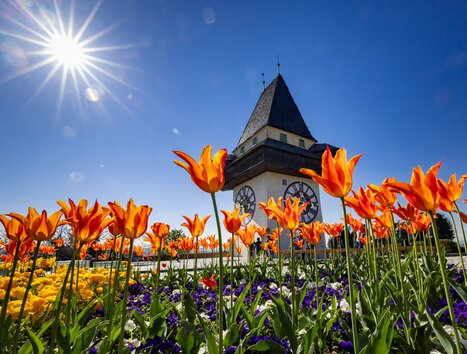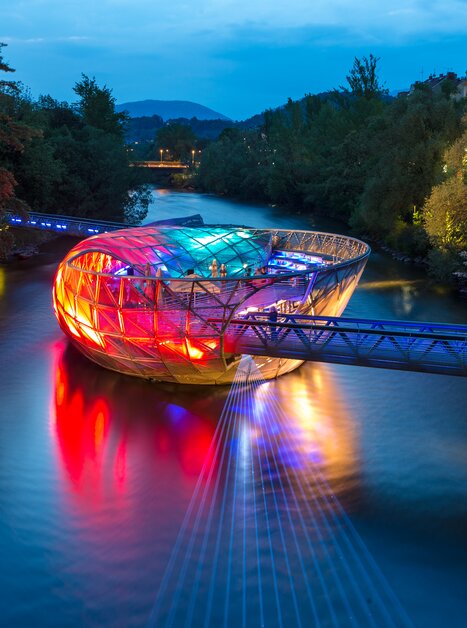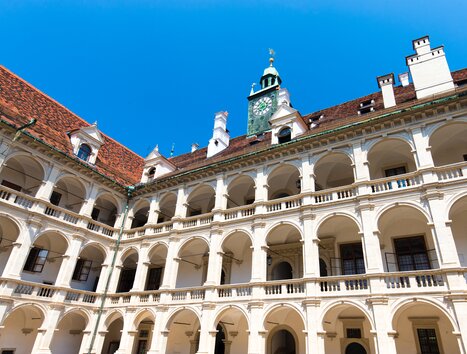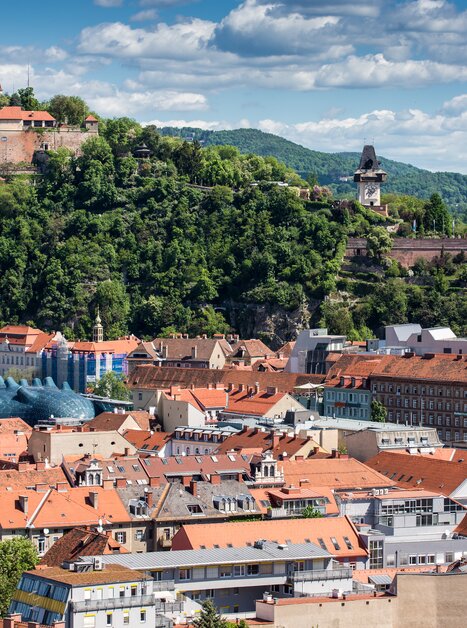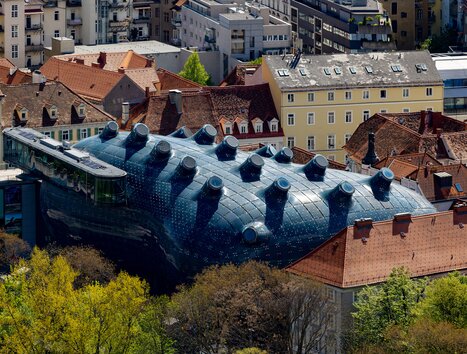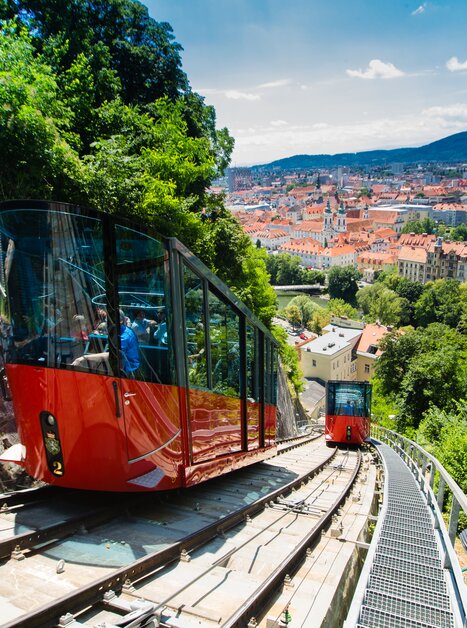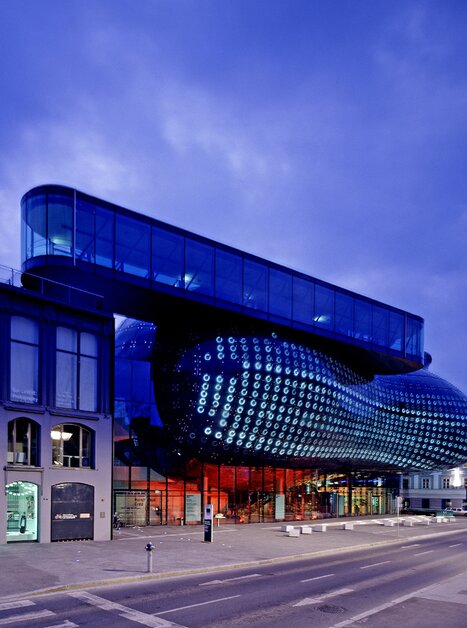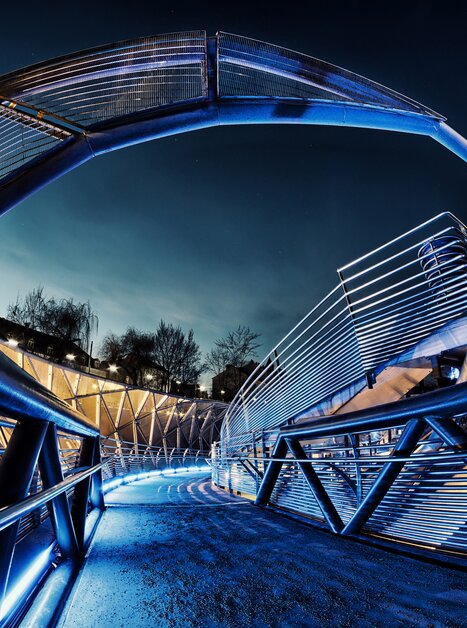The sights of Graz
All sights at a glance
There is plenty to see and do in Graz – but some sights are simply too good to miss! Crossing Mursteg bridge, you get a 360-degree view of some of the city’s most famous landmarks, including the Schlossberg and the clock tower as well as Mur river and the Island in the Mur. From the pedestrian bridge, you can also see the Church of Mariahilf with its two distinctive spires. Another sight to behold is that of the Kunsthaus, or “friendly alien“, at any time of day.
Sights Worth Seeing in Graz
The best tips for possible activities in Graz
Explore the Ten Most Popular Sights in Austria’s Capital of Culinary Delight – Graz: Take the Schlossberg funicular or glass elevator up to the iconic Schlossberg hill! Then don't miss the Graz Cathedral and the neighboring Mausoleum. Right across the square, climb the remarkable Gothic Double Spiral Staircase. Visit the Landhaus, home to the Styrian Armoury, which houses the world’s largest historical collection of weapons and armor. Just around the corner, you’ll find the charming Glockenspiel. To reach the stunning Eggenberg Palace, we recommend taking tram line 1. The palace features several museums and a beautiful park. We’ve selected the top ten must-see attractions in Graz for you – experience the vibrant capital of Styria in southern Austria up close!
The historic centre of the city of Graz was declared a UNESCO World Heritage Site in 1999. Eggenberg Palace was added in 2010. The old town centre and the palace display different architectural styles. It is rare to find a city whose history can be read in its buildings. Important architects and artists from different regions have created this impressive mix in Graz.
In 2008, Graz was officially awarded the title of ‘Capital of Delight’. But what actually makes Graz a Capital of Delight? Restaurateurs who are great hosts, who rely on their own regional products and who demonstrate the courage to come up with creative creations on a daily basis. It is thanks to these culinary talents and chefs that the capital of Styria has been honoured as the ‘Capital of Delight’. Outstanding ingredients processed by passionate chefs: The result can only be tasty! Especially as Graz's culinary calendar offers fine specialities right ‘on the doorstep’ all year round.
Graz is one of 46 ‘UNESCO Cities of Design’ worldwide. Since 2011, the city has been pursuing the goal of using design to drive urban development. The lively creative scene and internationally renowned schools and universities play an important role in this. But many visionary companies also see design as an opportunity for sustainable development. You can find more information on the following website: ‘City of Design’ .
- Take the Schlossberg funicular up the hill and pay a visit to the city’s landmark, the Graz Clock Tower.
- Stroll down Herrengasse, the main shopping street in Graz, and admire the impressive Baroque facades.
- Say hello to the snowman statue in the courtyard of the Priest Seminary.
- Watch the friendly "Stadtpark-Hansis" (squirrels) in Graz Stadtpark.
- Enjoy traditional Styrian cuisine – ideally at one of the GenussHauptstadt (Capital of Culinary Delight) partner restaurants.
- Take in the panoramic view over Graz at the Freiblick rooftop café on top of Kastner & Öhler department store.
- Visit the Kunsthaus Graz, affectionately nicknamed the “Friendly Alien” by locals.
- Wander from stall to stall at one of the many farmers' markets and sample local specialties.
- Meet up at the Weikhard Clock on Main Square – a popular local meeting spot.
- Grab an open-faced sandwich at Delikatessen Frankowitsch – a Graz classic.
- Cross the Mur River via the unique Murinsel (Mur Island).
- Admire the vibrant street art while strolling through the Gries and Lend districts.
- Watch the dancing couple at the Graz Glockenspiel.
- Slide down the Schlossberg Slide – and try to set a new personal record!
- Buy an ice cream in one of the icecream shops in Sporgasse, known as Graz’s “Ice Cream Mile”.
- Join a guided tour of the Styrian Armoury and marvel at the world’s most significant historical weapons collection.
Seasonal Highlights:
- Spring: Take part in a guided walking tour of the Old Town.
- Summer: Enjoy a picnic in the gardens of Eggenberg Palace.
- Autumn: Go on a cycling tour through the region.
- Winter: Warm your hands with roasted chestnuts and sip a mulled wine at one of the city’s charming Christmas markets.
